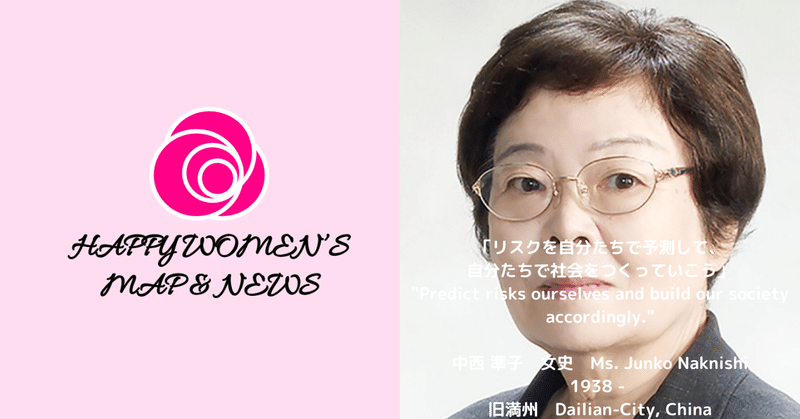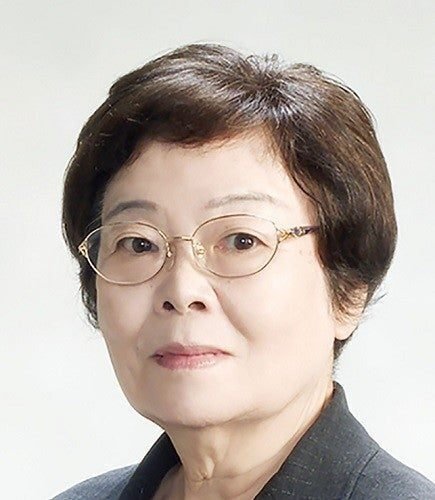
Happy Women's Map 旧満州 環境リスク管理学の創始者 中西 準子 女史

「リスクを自分たちで予測して、自分たちで社会をつくる」
"Predict risks ourselves and build our society accordingly."
中西 準子 女史
Ms. Junko Naknishi
1938 -
中国大連市 生誕
Born in Dailian-City, China
中西準子女史は環境リスク管理学の創始者です。化学物質による人の健康さらに生態系に与えるリスクを評価する手法を確立しました。
Ms. Jyunko Nakanishi is a pioneer in environmental risk management. She established methods for assessing the risks posed by chemical substances to human health and ecosystems.
*******
「どちらの考えが正しいのだろう」
準子は中国の大連で、南満州鉄道で働く父・功と、大連の図書室に勤める母・方子のもと、2人姉妹の長女として誕生。上海に引っ越してまもなく共産主義運動家の父・功はゾルゲ事件関連で検挙され東京の巣鴨拘置所に連行されます。とても豊かだった生活が一変、今まで親切にしてくれた人達から急に石を投げられる生活になります。母・方子は姉妹を連れて大連市の孤児院に身を寄せて住み込みで働こうとしますが、準子は臭いご飯にハンガーストライキをして反発。母は姉妹を連れて日本の父を追いかけます。門司港まで船で着くと、父の実家を訪ねますが戦時下の貧しさと家父長制・封建制の理不尽で陰湿な生活に逃げ出します。藤沢市鵠沼海岸に住む父の弟・三洋また富貴子夫妻の家に転がり込みます。父に死刑求刑がされる中、3人はたびたび巣鴨拘置所まで会いに行きます。敗戦を迎えようやく釈放された父が日本共産党員として凄まじい理論闘争をする現場を、準子は怖いと思いながらじっと見て育ちます。準子は小学生から広くマルクス主義の本を読みあさり、中学生で東大の大学院生が開く地域ゼミに参加、高校では社会科学研究会に所属、大学では技術革新の中身をのぞこうと横浜国立大学で化学工学を専攻します。
「多くに人にとってもファクトと思えるもの」
さらに準子は、東京大学の歴史上10番目の女性として応用化学のドクターを取得。化学工業全盛期にもかかわらず、準子につられて女性の給与が高くなることを嫌厭され就職先が見つかりません。ちょうどその頃、水俣病の工場排水を研究する宇井純博士の推薦より、東大工学部に新設されながら研究者らから嫌厭されている汚水・下水・工場排水を扱う都市工学の助手に抜擢されます。早速、準子は東京に新設された浮間排水処理場(のちの浮間水再生センター)に流入する物質毎のマスバランス(物質収支)を調査。水銀・鉛・銅・クロム・カドミウムの50%以上が汚泥に移行せず河川に流出している結果を得ます。東京水道局・大学・マスコミが発表を阻止する中、宇井純博士はじめ華山謙博士ならびに岡本雅美博士の推薦により1971年「公害研究」創刊号に調査結果を発表。準子は研究費を削減され大学・学会から村八分にされ、研究室の学生たちは進学また就職を妨害されますが、さらに小台下水処理場で焼却処理される汚泥中の重金属毎のマスバランスを調査。水銀・ヒ素・カドミウムの50%以上が灰に残存せず気化する結果を得ます。これらの調査結果は住民運動を引き起こし、浮間排水処理場は廃止され、1976年下水道法の改正により工場排水は厳しく規制されます。
「意思決定のための未来予測」
「壊し屋」と土木界から罵られる中、準子は水循環という観点から、いくつもの市町村から下水を集めて下流で一括処理する「流域下水道」に反対。不経済性指数を提案して下水道では規模が大きいほど不経済になることを証明します。さらに、人口密度に応じた下水道計画を提案、1982年に家庭毎の下水処理施設「個人下水道(現在の家庭用合併処理浄化槽)」を開発します。そして準子は水循環の一環をなす下水道をつくるために、アメリカのミシガン州立大学でリスク評価の研究手法を学びます。帰国後、日本の水道水中発がん物質のリスク評価を発表、発がんリスクは一生水道水を飲み続けると10万人あたり2~8件、リスク削減費用は1件あたり4~11億円、汚染のひどくない地域で塩素処理の代わりにオゾン処理を導入するのは不適切であり、リスク削減のコストの重要性を提起します。「人命軽視」と市民団体から批判される中、横浜国立大学環境科学研究センター教授に就任した準子は、ダイオキシン対策としてのごみ処理焼却施設の広域化・巨大化またRDF発電に反対。ダイオキシン類の発生源を追跡するために宍道湖また東京湾の底質資料を分析、さらに農家の物置を探し回って、ダイオキシンが焼却炉起源ではなく過去に製造・使用された農薬起源であることを突き止めます。新しく発足した産業技術総合研究所の化学物質リスク管理研究センター長に就任した準子は、化学物質のリスク評価書を作成、さらに化学物質の大気中濃度を排出量と気象条件から計算するソフトウェア(ADMER)を開発。リスクを自分たちで予測して、自分たちで社会をつくっていくことを呼びかけています。
"Which of these ideas is correct?"
Junko was born in Dalian, China, as the eldest daughter of her parents, Gong, who worked for the South Manchuria Railway, and Fangzi, who worked at the library in Dalian. Shortly after moving to Shanghai, her father, Gong, a communist activist, was arrested in connection with the Zorge Incident and taken to Tokyo's Sugamo Prison. Their once-affluent life took a sudden turn, and the people who had been kind to them started hurling stones. Junko's mother, Fangzi, tried to live and work at an orphanage in Dalian with her two daughters, but Junko rebelled by going on a hunger strike due to the unpleasant food. Her mother decided to follow their Japanese father. Upon arriving in Moji Port, they visited her father's family, but they faced a harsh life due to the poverty of wartime and the injustices of the patriarchal and feudal society. They ended up staying with Gong's younger brother, Sanyo, and his wife Fukiko, who lived in Kugenuma Kaigan, Fujisawa. While her father was facing a death sentence, Junko and her family frequently visited Sugamo Prison to see him. Junko grew up, observing the intense ideological battles her father, a member of the Japanese Communist Party, engaged in, despite her fear. Junko delved into Marxist literature from her early school days, and in middle school, she participated in regional seminars conducted by graduate students from the University of Tokyo. In high school, she joined the Social Science Research Society, and at the university, she majored in chemical engineering at Yokohama National University, all the while aiming to explore the essence of technological innovation.
"What could be considered "facts" by the majority of people ?"
Furthermore, she became the 10th woman in the history of the University of Tokyo to earn a doctorate in applied chemistry. Despite the booming chemical industry, she struggled to find a job as she was not comfortable with the idea of women being paid more because of her influence. At that time, she was recommended by Dr. Jun Ui, who was researching factory wastewater related to Minamata disease, to become an assistant in urban engineering, specializing in wastewater and factory sewage treatment, at the University of Tokyo. She immediately initiated a mass balance (material balance) investigation of substances flowing into the Fukamizu Wastewater Treatment Plant (later known as Fukamizu Water Reclamation Center) newly established in Tokyo. The results showed that more than 50% of mercury, lead, copper, chromium, and cadmium did not transfer to sludge but were discharged into rivers. However, the Tokyo Waterworks Bureau, the university, and the mass media tried to prevent the publication of these findings. With the recommendations of Dr. Jun Ui, Dr. Kengo Kayama, and Dr. Masami Okamoto, her research results were published in the inaugural issue of the "Public Hygiene Research" in 1971. Junko's research funding was reduced, she was ostracized by the university and academic societies, and her students were hindered from advancing their education or finding employment. Despite this, she further investigated the mass balance of heavy metals in sludge incinerated at the Odaira Sewage Treatment Plant. Her results showed that more than 50% of mercury, arsenic, and cadmium did not remain in the ashes but vaporized. These findings triggered a citizen movement, leading to the closure of the Fukamizu Wastewater Treatment Plant and strict regulations on factory wastewater through a 1976 amendment to the Sewage Law.
"Future Prediction for Decision-Making"
Amid the criticism of being a "wrecker" and facing the denunciation of the civil engineering community, Junko opposed the "watershed sewer system" that collects sewage from multiple towns and treats it collectively downstream, advocating the proposal of an uneconomical index, proving that larger sewage systems were less cost-effective. Furthermore, she proposed sewage system plans based on population density and developed "individual sewage systems (present-day home-use combined treatment septic tanks)" in 1982. To contribute to the creation of a sewer system as part of the water cycle, she studied risk assessment methods at Michigan State University in the United States. Upon returning to Japan, she published risk assessments of carcinogenic substances in tap water. Her research revealed that the risk of cancer caused by lifelong consumption of tap water ranged from 2 to 8 cases per 100,000 people. She emphasized the importance of the cost of risk reduction, with costs ranging from 400 to 1,100 million yen per case. She also argued that it was inappropriate to replace chlorine treatment with ozone treatment in areas with low pollution, highlighting the importance of cost in risk reduction. Despite criticism of "disregarding human life" from citizen groups, Junko became a professor at Yokohama National University's Environmental Science Research Center. In her role, she opposed the expansion and gigantism of waste incineration facilities and RDF power generation as part of dioxin countermeasures. She analyzed the bottom sediment of Lake Shinji and Tokyo Bay to trace the origins of dioxins and discovered that dioxins originated from pesticides manufactured and used in the past, rather than from incinerators. Upon becoming the head of the Chemical Substance Risk Management Research Center, a newly established unit at the National Institute of Advanced Industrial Science and Technology, Junko created risk assessment reports for chemical substances and developed software (ADMER) to calculate atmospheric concentrations of chemical substances based on emission levels and meteorological conditions. She urged people to predict and shape society by themselves."
-日本学士院 Japan Academy
-横浜国立大学 Yokohama National Univ.

Share Your Love and Happy Women's Story!
あなたを元気にする女性の逸話をお寄せください!
Share your story of a woman that inspires you!
この記事が気に入ったらサポートをしてみませんか?
